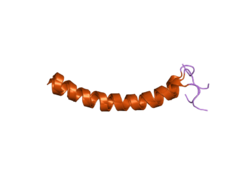LL-37
| LL-37 | ||
|---|---|---|

|
||
| 3D structural model of LL-37 | ||
| other names |
|
|
| Properties of human protein | ||
| Mass / length primary structure | 37 amino acids | |
| Precursor | (170 amino acids) | |
| Identifier | ||
| Gene name | CAMP | |
| External IDs | ||
| Transporter classification | ||
| TCDB | 1.C.33.1.10 | |
| designation | Cathelicidin family ( Porine ) | |
| Occurrence | ||
| Parent taxon | Vertebrates | |
| Orthologue | ||
| human | House mouse | |
| Entrez | 820 | 12796 |
| Ensemble | ENSG00000164047 | ENSMUSG00000038357 |
| UniProt | P49913 | P51437 |
| Refseq (mRNA) | NM_004345 | NM_009921 |
| Refseq (protein) | NP_004336 | NP_034051 |
| Gene locus | Chr 3: 48.22 - 48.23 Mb | Chr 9: 109.85 - 109.85 Mb |
| PubMed search | 820 |
12796
|
LL-37 is a human antimicrobial peptide belonging to the cathelicidins group . It is mainly produced in immune cells and is part of the innate immune response as well as the apoptosis of the body's own cells. It is a transport protein whose incorporation into the cell wall of Gram-positive bacteria on the one hand and into the cell membrane on the other hand leads to a loss of ions and small molecules. It is through the CAMP - gene encodes .
The production of LL-37 is especially by stimulating TLR-9 through, but also TLR-2 and TLR-4 and indirectly vitamin D stimulated.
biosynthesis
The biosynthesis of LL-37 is a multi-step process. It is encoded by the CAMP gene on chromosome 3 . This gene, like the cathelicidin genes in other mammals , consists of four exons . The antimicrobial activity is encoded by the hypervariable exon 4, while exons 1 to 3 encode a signal peptide sequence and the subsequent cathelin domain.
A prepropeptide is primarily synthesized and stored in the granules of neutrophil granulocytes or other cells. After these biologically inactive propeptides have been released, they are enzymatically cleaved by elastase or other proteinases into a cathelin and a C-terminal antimicrobial peptide, the 37 amino acid LL-37.
In the one letter code is the peptide sequence of LL-37 LLGDFFRKSKEKIGKEFKRIVQRIKDFLRNLVPRTES.
literature
Zanetti M: The role of cathelicidins in the innate host defenses of mammals . (PDF) In: Curr Issues Mol Biol . 7, No. 2, July 2005, pp. 179-96. PMID 16053249 .
Individual evidence
- ↑ Search result Cathelicidins by taxonomy
- ↑ UniProt P49913
- ↑ Rivas-Santiago B, Hernandez-Pando R, Carranza C, et al. : Expression of cathelicidin LL-37 during Mycobacterium tuberculosis infection in human alveolar macrophages, monocytes, neutrophils, and epithelial cells . In: Infection and Immunity . 76, No. 3, March 2008, pp. 935-41. doi : 10.1128 / IAI.01218-07 . PMID 18160480 . PMC 2258801 (free full text).
- ↑ Yuk JM, Shin DM, Lee HM, et al. : Vitamin D3 induces autophagy in human monocytes / macrophages via cathelicidin . In: Cell Host Microbe . 6, No. 3, September 2009, pp. 231-43. doi : 10.1016 / j.chom.2009.08.004 . PMID 19748465 .
- ↑ Tomasinsig L, Zanetti M: The cathelicidins - structure, function and evolution . In: Curr. Protein pept. Sci. . 6, No. 1, February 2005, pp. 23-34. PMID 15638766 .
- ↑ A. Pini, C. Falciani et al. a .: A novel tetrabranched antimicrobial peptide that neutralizes bacterial lipopolysaccharide and prevents septic shock in vivo. In: FASEB journal. Volume 24, Number 4, April 2010, pp. 1015-1022, ISSN 1530-6860 . doi : 10.1096 / fj.09-145474 . PMID 19917670 .